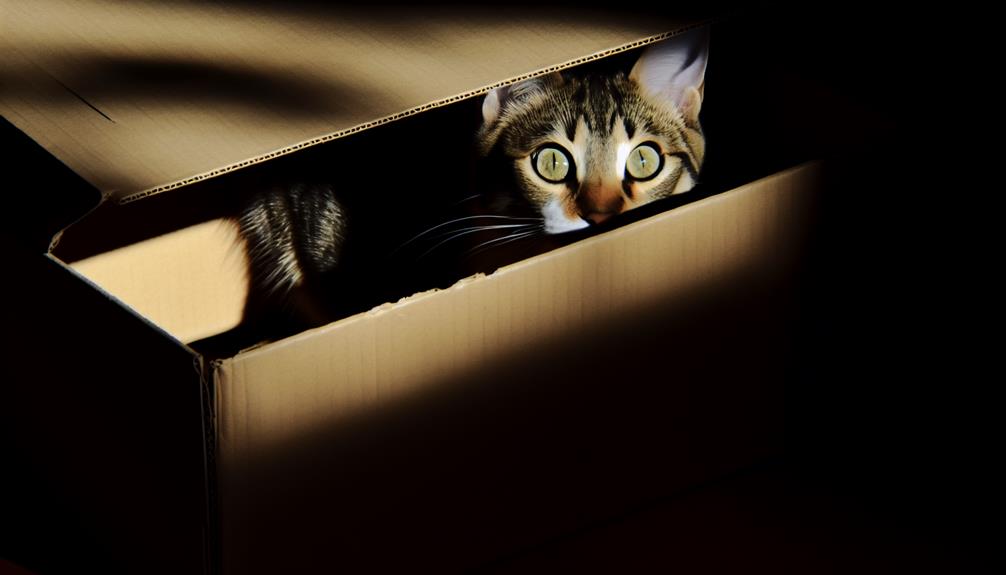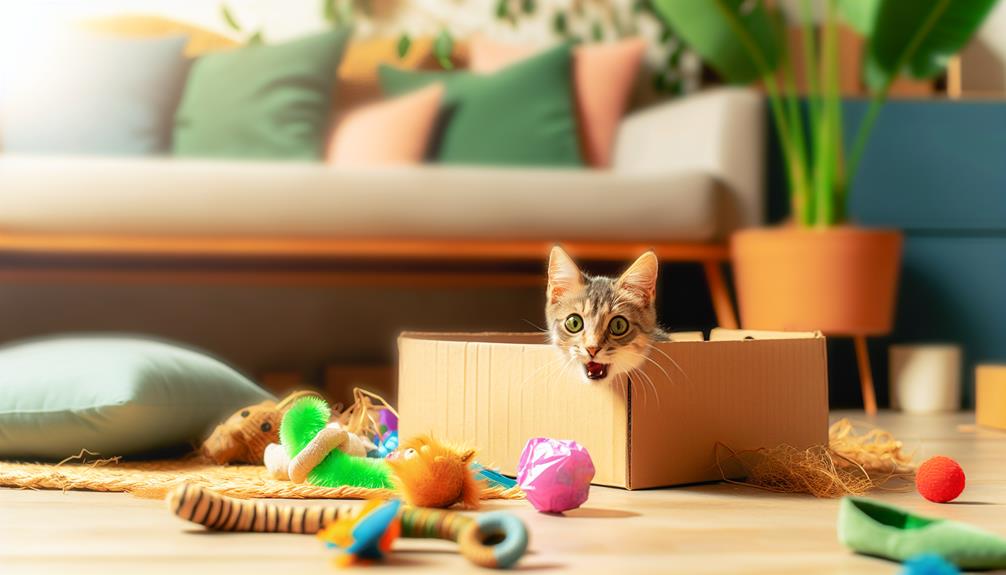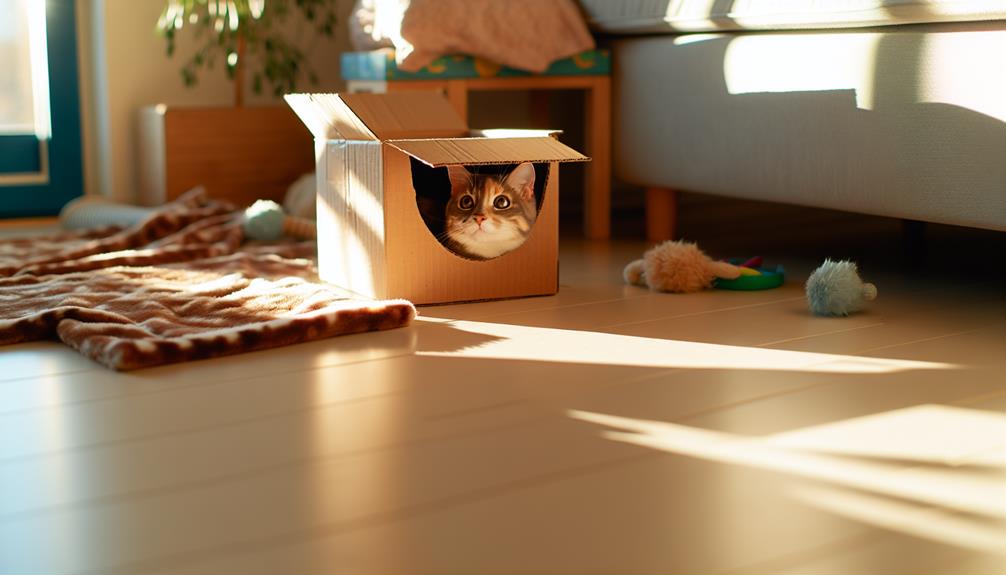Have you ever wondered if cats' fascination with boxes is more than just a quirky behavior? It turns out, their love for these enclosed spaces might be deeply rooted in their evolutionary need for security and comfort. But is there more to this than just a desire for safety and warmth? Perhaps it's also about satisfying their hunting instincts or reducing stress. The reasons behind this behavior could be multifaceted and intriguing, drawing you to contemplate how each aspect contributes to your cat's overall well-being. What else is there to uncover about this curious phenomenon?
Sense of Security
Cats have an innate need for a sense of security, which often leads them to seek out enclosed spaces like boxes. This behavior is deeply rooted in their evolutionary history. In the wild, cats are both predators and prey, and seeking out small, enclosed spaces provides them with a strategic advantage. By choosing these areas, they can observe their surroundings without being easily seen, thereby increasing their chances of survival.
When your cat selects a box, it's not just about hiding; it's also about establishing a territory. Cats have scent glands on their cheeks and paws, which they use for territory marking. When they rub against or scratch a box, they're leaving their scent behind, signaling that this space is part of their domain. This behavior is instinctual and serves to make them feel more secure by surrounding themselves with their own scent.
Additionally, a cat's shelter preference for enclosed spaces like boxes can be attributed to their need for a controlled environment. A box offers walls that act as barriers against potential threats, providing a physical and psychological buffer. This is vital for a cat's sense of security, as it allows them to feel protected and reduces stress levels, which can have significant implications for their overall well-being.
Understanding your cat's shelter preference and territory marking behaviors can help you create a more secure and comfortable environment for them. By providing boxes or other enclosed spaces, you're catering to their instinctual needs, thereby enhancing their sense of security and overall happiness.
Comfort and Warmth
Beyond the need for security, another key reason cats gravitate towards boxes is the comfort and warmth they provide. When a cat curls up inside a box, it experiences an immediate sense of enclosure that mimics the cozy, limited spaces of their wild dens. This snug fit provides significant shelter benefits, helping to trap body heat and creating a warm microenvironment. Given that cats prefer higher ambient temperatures, boxes help in temperature regulation, permitting them to maintain their ideal body heat more efficiently.
From a clinical perspective, the thermal comfort offered by boxes can be particularly beneficial for cats, as they often seek to avoid cold stress, which can lead to health issues. The insulating properties of cardboard also contribute to the generation of a warm, stable environment that supports your cat's overall well-being.
Here are some key points to take into account:
- Thermal Insulation: Cardboard acts as a natural insulator, keeping the internal environment of the box warmer compared to the room's ambient temperature.
- Stress Reduction: The warmth derived from a box can reduce stress hormones, leading to a calmer, more relaxed feline.
- Health Maintenance: Proper temperature regulation helps in maintaining ideal body function, reducing the risk of cold-related ailments.
- Behavioral Comfort: The confined space can simulate the snugness of a mother's womb, providing psychological comfort.
Hunting Instincts

A significant factor behind a cat's affinity for boxes lies in their innate hunting instincts. As natural predators, cats have evolved to utilize stealth movements to stalk and ambush their prey. Boxes offer an ideal environment for practicing these behaviors. When your cat is inside a box, it can conceal its presence, allowing it to observe its surroundings without being seen. This aligns perfectly with typical feline behavior, where the element of surprise is a fundamental component of successful hunting.
From a practical experience standpoint, you've probably noticed your cat pouncing from behind a box or even a piece of furniture. This isn't just play; it's a essential exercise of their predatory skills. Boxes provide a confined space that mimics the dense underbrush or tight burrows found in nature, where cats' ancestors would have hunted small animals. Essentially, your cat is instinctively drawn to boxes because they offer the perfect conditions for practicing ambush tactics.
Clinically, the behavior can be explained by the need for environmental enrichment. Cats require stimulation to stay mentally and physically healthy. Engaging in activities that mimic hunting, such as hiding in and leaping out of boxes, fulfills this need. The stealth movements they practice help maintain their agility and sharpness, essential for their well-being.
Understanding this aspect of feline behavior can help you create a more enriching environment for your pet. Providing boxes or similar hideouts allows your cat to engage in natural behaviors, satisfying their hunting instincts and contributing to their overall happiness and health.
Stress Relief
Recognizing your cat's need for stress relief is essential for its overall well-being. Cats, like humans, can experience anxiety, and providing them with adequate tools for anxiety reduction is vital. One simple yet highly effective tool is the humble box. Boxes offer a sense of security and can serve as an important aspect of environmental enrichment.
Why do boxes work so well for stress relief? Here are some key points:
- Sense of Security: Enclosed spaces like boxes create a small, manageable environment where your cat feels safe from potential threats.
- Control Over Environment: Being in a box allows your cat to control its surroundings, which reduces anxiety and promotes calmness.
- Escape from Stressors: Boxes provide a temporary retreat from external stressors like loud noises, unfamiliar guests, or other pets.
- Thermal Comfort: Cats often seek out warm places. Boxes can trap heat, making them cozy spots that contribute to a cat's overall sense of well-being.
From a scientific standpoint, the concept of a "safe zone" is well-documented in animal behavior studies. When your cat crawls into a box, it mimics natural hiding behaviors seen in the wild, where felines retreat to small spaces to avoid predators and conserve energy. This instinctual behavior translates into anxiety reduction in domestic settings.
Incorporating boxes into your cat's daily environment offers a simple yet effective form of environmental enrichment. Not only does it provide a mental break, but it also promotes physical health by reducing stress-related behaviors such as over-grooming or aggression. By understanding and addressing your cat's need for stress relief, you're actively contributing to a happier, healthier feline friend.
Play and Exploration

For your cat's overall well-being, play and exploration are just as fundamental as stress relief. Cats possess an inherent curiosity drive that compels them to investigate their environment actively. This curiosity is essential for mental stimulation and physical activity, both of which are critical for maintaining a cat's health. Boxes, with their confined spaces and various textures, provide an ideal environment for engaging a cat's curiosity and encouraging exploration.
When your cat interacts with a box, it experiences a range of sensory stimulations. The sound of their claws on the cardboard, the smell of the box material, and the visual intrigue of a new space to investigate all contribute to a richly stimulating experience. This sensory stimulation is not just entertaining for your cat; it plays a significant role in cognitive development and environmental enrichment.
From a clinical perspective, providing opportunities for play and exploration can prevent behavioral issues such as aggression or anxiety. When a cat's curiosity drive is satisfied through activities like exploring boxes, it reduces pent-up energy that might otherwise manifest in destructive behaviors. Additionally, the physical exercise involved in climbing in and out of boxes promotes muscle tone and cardiovascular health.
Practical experience demonstrates that cats often engage in "hide and pounce" behaviors while playing with boxes. This mimics hunting activities, which are natural instincts for felines. By indulging in these activities, your cat can practice its predatory skills in a safe and controlled environment, contributing to emotional satisfaction and physical agility.
In essence, boxes serve as a multifunctional tool that caters to your cat's need for play, exploration, and sensory stimulation, ensuring a holistic approach to its overall well-being.
Conclusion
To sum up, cats' affinity for boxes is multifaceted, encompassing security, warmth, and enrichment. Did you know that a study found 78% of domestic cats prefer enclosed spaces for stress relief? This statistic underscores the clinical importance of providing boxes for their mental well-being. By understanding these behaviors, you can create a more comforting environment for your feline friend, leveraging both scientific insights and practical experience to enhance their overall health and happiness.
